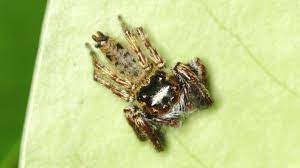Today’s Current Affairs: 26th Dec 2023 for UPSC IAS exams, State PSC exams, SSC CGL, State SSC, RRB, Railways, Banking Exam & IBPS, etc
Table of Contents
New Jumping Spiders : Discovered

A team of researchers from Kerala and Tamil Nadu have discovered two new species of jumping spiders that belong to the genus Afraflacilla. Recent findings have revealed the presence of the genus in Rajasthan, Kerala and Tamil Nadu
- Specimens of Afraflacilla Kerala were spotted in Irinjalakuda and Kuttanad while Afraflacilla adavathurensis was discovered from Adavathur in Tiruchirappalli.
- Only three species belonging to the Afraflacilla genus had been hitherto discovered in the country.
- According to the researchers, these species have interesting diagnostic features consisting of dark brown carapace with fine bands of white setae covering laterally.
- Their abdomens are light brown and display white bands formed of white hairs that cover it laterally.
- Jumping spiders of the genus Afraflacilla are widespread from Africa to Australia with various known species found in Middle East, South and Southeast Asia, Central, Eastern and Western Europe, numerous African countries and Australia.
Epulopiscium Viviparus : Giant Bacteria

Scientists have sequenced the genome of a mysterious species of giant bacterium Epulopiscium Viviparus that can be seen without a microscope.
- Epulopiscium Viviparus is a bacteria which live symbiotically in the guts of a fish, Naso tonganus, in tropical ocean environments.
- The first member of Epulopiscium whose name comes from the Latin words for “a guest” and “of a fish” was discovered in 1985.
- Epulopiscium Viviparus has modified its metabolism to make the most of its environment, by using a rare method to make energy and to move and by devoting a huge portion of its genetic code to making enzymes that can harvest the nutrients available in its host’s gut.
- It makes enzymes that are highly efficient at nutrient extraction from their host fish, especially carbohydrates called polysaccharides from the algae that forms a large part of N. tonganus’s diet.
- It has plentiful enzymes that make ATP too, the ‘energy currency’ that supports a wide variety of cellular processes.
- Researchers discovered space for these molecules in a unique membrane, similar to the mitochondria of more complex organisms.
8th Edition Of Indian Ocean Naval Symposium:

The 8th edition of Indian Ocean Naval Symposium (IONS) Conclave of Chiefs (CoC) was conducted by Royal Thai Navy at Bangkok, Thailand.
- The ‘Indian Ocean Naval Symposium’ (IONS) is a voluntary initiative that seeks to increase maritime cooperation among navies of the littoral states of the Indian Ocean Region by providing an open and inclusive forum for discussion of regionally relevant maritime issues.
- It was conceived by the Indian Navy in 2008 as a forum which seeks to enhance maritime cooperation among Navies of the littoral states of the Indian Ocean Region.
- The inaugural edition of IONS was held in Feb. 2008 at New Delhi, with the Indian Navy as the Chair for two years (2008 – 2010).
- It endeavours to generate a flow of information between naval professionals that would lead to common understanding and possibly cooperative solutions on the way ahead.
Leprosy a Reportable Disease In The State : Odisha Government

The Odisha government recently declared leprosy a reportable disease in the state.
- Leprosy, also known as Hansen’s disease, is a chronic infectious disease caused by a type of bacteria, Mycobacterium leprae.
- The disease predominantly affects the skin, the peripheral nerves, the mucosal surfaces of the upper respiratory tract, and the eyes.
- Left untreated, the disease may cause progressive and permanent disabilities.
- It is more common in tropical and subtropical areas.
- It is a neglected tropical disease (NTD)that still occurs in more than 120 countries.
- It is known to occur at all ages, ranging from early childhood to old age.
- The disease is transmitted through droplets from the nose and mouth.
- Prolonged, close contact over months with someone with untreated leprosy is needed to catch the disease.
- The disease is not spread through casual contact with a person who has leprosy, like shaking hands or hugging, sharing meals, or sitting next to each other.
- It usually takes about 3 to 5 years for symptoms to appear after you come into contact with the bacteria that cause leprosy.
- The main symptom of leprosy is disfiguring skin sores, lumps, or bumps that don’t go away after several weeks or months.
- It is curable with multidrug therapy (MDT),and treatment during the early stages can prevent disability.
- Moreover, the patient stops transmitting the disease when they begin treatment.
Gelephu Project:

Bhutan’s King has announced plans to build a massive “international city” in an area of over 1,000 sq. km. on its border with Assam. This project is known as the Gelephu Project.
- Gelephu Smart City Project is expected to be an “economic corridor connecting South Asia with Southeast Asia via India’s northeastern States”.
- The city is expected to follow environmental standards and sustainability as a goal, and will aim to attract “quality investment” from “specially screened” international companies.
- The project is expected to include “zero emission” industries, a “mindfulness city” that plays to Bhutan’s strength in tourism and wellness, as well as infrastructure companies.
- The project is expected to be a “Special Administrative Region” that would be run under different laws to facilitate more international investment.
- The project is expected to be a “point of inflection” and “transformation” for Bhutan and South Asia.
- The Government of India agrees to construct the first India-Bhutan railway line to Gelephu.
- The railway will also connect with roadways and border trading points into Assam and West Bengal, eventually providing Bhutan access to Myanmar, Thailand, Cambodia, and Singapore.
National Consumer Rights Day 2023:

India celebrates National Consumer Rights Day on 24th December every year to raise awareness about consumer rights and responsibilities. The World Consumer Rights Day is observed on 15 March.
- The day commemorates the day when the Consumer Protection Act 1986 received the President’s assent on December 24, 1986.
- The Act aims to protect consumers from defective goods, negligent services, and unfair trade practices.
- The six fundamental rights of the Consumer Protection Act are the Right to safety, the Right to choose, the Right to be informed, the Right to be heard, the Right to seek redressal and the Right to consumer education.
- The Consumer Protection Act, 2019 was passed by the Parliament to replace the Consumer Protection Act, 1986.
Pandit Madan Mohan Malaviya Birth Anniversary:

On the 162nd birth anniversary of Pandit Madan Mohan Malaviya on 25th December 2023, the Prime Minister is scheduled to release the first series of the ‘Collected Works of Pandit Madan Mohan Malaviya.’
- The bilingual (English and Hindi) work features writings, speeches, unpublished letters, and other works of Madan Mohan Malaviya.
- Madan Mohan Malaviya (25th December 1861 – 2nd November 1946) was an Indian scholar, politician, and educational reformer.
- He was a leader in the Indian independence movement and served as president of the Indian National Congress four times.
- He was also the founder of the Akhil Bharat Hindu Mahasabha and the Banaras Hindu University.
Iridescent Clouds : Spotted

Iridescent clouds, known as nacreous clouds, were spotted over parts of Scotland, northern England, and the West Midlands recently.
- The clouds, resembling mother of pearl, are known for their pastel light reflections during sunset and sunrise.
- This phenomenon occurs as sunlight diffracts around tiny ice crystals within the clouds, creating an effect similar to a thin layer of oil on water.
- Nacreous clouds are rare in the UK and are usually seen when cold air from the polar vortex temporarily hovers over the region.
- Iridescent clouds is diffraction, which occurs when small water droplets or small ice crystals scatter the sun’s light.
- Larger ice crystals do not produce iridescence but can cause halos.




